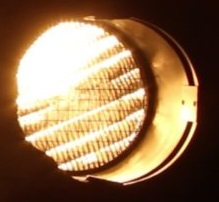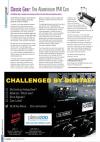UNDER CONSTRUCTION
[Candles ( – 1800s)]
See also the Sam Wanamaker Playhouse, which uses candles to replicate the unique experience.
[Oil (1500s – 1800s)]
From TABS (1957)
The use of ‘floats’ became more general in Garrick’s time; they consisted of wicks floating in oil.
[Gas (1810s)]
From TABS, Vol 5 Issue 2 (1947)
Theatre Royal Drury Lane first used gas in both stage and auditorium on 6th September 1817, and was therefore the first theatre to use gas lighting throughout the venue.
The Lyceum first used gas on the stage on 6th August 1817, and in the auditorium on 8th September 1817. It was the first theatre to use gas lighting on stage, following experiments in 1803/4.
From TABS, Vol 5 Issue 1 (1947)
The Theatre Royal Haymarket was the last of the London theatres to use gas for lighting. Oil was used until April 15th 1853.
From TABS, Vol 15 Issue 3 (1957)
Covent Garden had introduced gas lighting but in 1828 closed the theatre for a week to enable the equipment to be removed, stating on a November playbill:
The Reopening of Covent Garden Theatre.
The Public attention is respectfully solicited to the following Facts:-
The Gasometers, and Apparatus for making Gas, are destroyed, and no more Gas will be manufactured within the walls of the Theatre.
The Circles of Boxes will be illuminated with Wax.
The Lights in the front of the Stage, and of every internal avenue to Box, Pit and Galleries, will be produced by the agency of the purest oil.
[Limelight]
An obsolete source of intensely bright light, most recently used in followspots.
Derived from a burning jet of oxygen and hydrogen impinging on a rotatable cylinder of lime.
The source of the phrase ‘in the limelight’.
Limelight was first used for indoor stage illumination at the Covent Garden Theatre in 1837, and by the 1860s it was in wide use in a number of theatres around the world.
Electricity – Arc
An intense bright white light is created by an arc of electrical current flowing between two carbon rods.
Electricity – Incandescent

Glow from a 1kW Parcan
Light is produced by a metal filament which glows white-hot when electrical current is passed through it.
Incandescent lamps produce a warm light, which increases in red-content as it is dimmed (known as Redshift).
The warmth / coolness of a lamp is known as it’s Colour Temperature and is measured in degrees Kelvin.
Lamps have a number of variables as well as the wattage, which means you have to use the correct lamp in a given fixture.

LSI: Classic Gear - Incandescent Light Bulb (January 2009)
[External Website]
From Lighting & Sound International
- The lamp base consists of two connections, usually in the form of pins. The size and separation of these pins varies enormously.
- The LCL (Light Centre Length) is a measurement of the height of the filament and ensures that the filament is lined up correctly inside the reflector. The measurement is from the top of the lamp base to the centre of the filament cluster.
- Operating Angle – Most lamps are designed to be operated with the base down, within a relatively limited range of tilt. There are some exceptions to this, but check the manufacturers instructions before mounting a lantern at an odd angle.
Prefixes
From Thorn EMI Studio, Theatre and Television Light Source Handbook (unknown date but before 1999)
“CP” prefix – Lamps designed for use in conjunction wtih film balanced for 3200K. these are single ended types intended for use in Fresnel, ellipsoidal luminaires etc.
“P2” prefix – Again for use with 3200K colour film stock for open faced luminaires and video sun guns.
“T” prefix – Lamps intended for theatre luminaires. These are of lower colour temperatures (2900-3050K) and longer life than the often similar CP types above.
ANSI Coded – A number of types are available made to American ANSI Specification and these use the random 3 letter codes allocated by the American National Standards Institute where performance specifications are on file. Lamps carrying the ANSI code are directly interchangeable with similarly coded US domestic products. They are generally rated for 120V.
Tungsten Halogen Lamps
- The Halogen Cycle
Chemical process occurring in Tungsten Halogen lamps which makes them possible. During the lamps life, Tungsten evaporates from the filament, and would normally deposit itself on the glass wall of a Tungsten lamp, causing it to blacken, and causing the output of the lamp to reduce until it finally blew. In a Tungsten Halogen lamp, the Tungsten combines with the Halogen gas elements present in the lamp envelope and is re-deposited back onto the filament. This process needs a very high temperature to operate, so Tungsten Halogen lamps are able to be a lot smaller, and run a lot hotter, than their Tungsten equivalents.
-
- UK Examples:
- CP60 / 61 / 62 / 95 (1000W) PAR64 lamps
- DXX (800W) Used in Redhead TV/Film lights
- GKV (600W)
- HPL (575W / 750W) Developed for the Source Four in 1992.
- K12 (150W) Linear Flood 78mm
- K9 (300W) Linear Flood 117mm
- K1 (500W) Linear Flood 117mm
- T Range – Theatre Lamps – lower colour temperature than the CP range, with longer life (around 750 hours)
- T29 (1200W)
- T11/T19 (1000W)
- T26/T27 (650W)
- T18/T25 (500W)
- See Lamps List for more
- UK Examples:
Blown Lamps and Maximising Lamp-Life
See the separate page about Fault-Finding for tips on how to get the best out of lamps.

LSI: Classic Gear - Aluminium Parcan (September 2010)
[External Website]
From Lighting & Sound International
Discharge
Discharge lamps are not dimmable, and produce an intense light from an electrical ‘arc’ between two electrodes in a gas.
Discharge lamps are used in architectural lighting (where the increased efficiency results in cost-savings) and in moving lights where they produce less radiant heat than incandescent lamps. Mechanical dimming systems are used to enable control of the light.
A ballast is required either as part of the lighting fixture, or as an external box, to limit the flow of current through the lamp, and to provide a high voltage to ‘strike’ the arc and start the lamp operating.
Discharge lamps require an amount of time to warm up, to operate at highest efficiency, and to produce the correct colour temperature. Once they’ve been on for a while, the lamp needs time to cool down before it can be re-struck. For this reason, discharge lamps must not be used on circuits that are switched on / off frequently, or with occupancy sensors in buildings.
- CDM (Ceramic Discharge Metal Halide) 150W
- CID (Compact Iodide Daylight) 5500K
- CSI (Compact Source Iodide) 4000K (used in followspots due to closeness of colour temperature to incandescent sources)
- HMI (Hydragyrum Medium arc-length Iodide) – Mercury Halide – 5600K
- HTI Hydrogen Metal Halide – 150W
- MBI
- MSD
- MSR (Medium Source Rare-Earth) Philips designation – Metal Halide lamp using dysprosium iodide as the gas. Osram names it HSR and GE CSR. 5900K. (Variants are available up to 7200K).
- Sodium
Lamp Bases
- Circular Lamp Bases (UK)
- BC (Bayonet Cap)
- ES (Edison Screw)
- GES (Giant Edison Screw)
- MES (Miniature Edison Screw) Low-voltage filament lamps for experimental kits, train sets, old torches etc.
- SBC (Small bayonet cap)
- SES (Small Edison Screw)
Keywords: Production of light, how is light produced? Different types of light, lime light history, limelight history types of bulbs, types of bubbles, types of lamps, light bulb types, light bulbs, limelights





